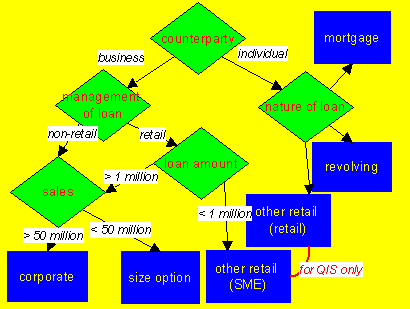QIS 3 FAQ: L. Retail Exposures
1. In assessing whether a small business qualifies for retail treatment, should banks determine its total exposure or that of its banking group to the small business?
Answer: Loans extended to small businesses are eligible for retail treatment provided the total exposure of the banking group (and NOT the bank) is less than €1 million. See the decision tree underneath for additional information.
Answer: Application of the revolving facilities treatment is not limited to credit cards. All revolving facilities that meet the requirements laid down in paragraph 195 of the Technical Guidance document can be included in this portfolio. Note that in order to make an decision on this issue you should contact your supervisor, since your supervisor has to concur that treatment as a qualifying revolving exposure is consistent with the underlying risk characteristics of the sub-portfolio.
3. In the standardised approach the concept of 'counterparty' to which the € 1 million limit applies seems to be applicable to the group of borrowers, in the IRB approach the text refers to 'exposure to an individual small business', does this imply that for IRB purposes we do not have to look at the group of borrowers?
Answer: In both cases the text should be interpreted as referring to a group of borrowers.
4. Under IRB, should 'dormant' overdrafts within limit, where no payment has been received within 90 days be treated as defaulted exposures?
Answer: If the account is within limit and the bank has not sought repayment from the customer, then there is no requirement to treat this exposure as defaulted (unless of course you consider it to be in default based on other information available to you).
5. Can derivatives be included in the retail portfolio?
Answer: Technically this is possible in the so-called 'other retail' portfolio. It is important, however, to ensure that we are really dealing with a retail exposure and not with an exposure that actually belongs in the corporate portfolio.5
6. Paragraph 195 of the Technical Guidance states that "if a bank can demonstrate that its sub-portfolio of revolving exposures exhibits a high ratio of future margin income (FMI) to expected loss, it may use the treatment for qualifying retail exposures. In general, FMI should cover the sum of expected losses and two standard deviations of the annualised loss rate on the sub- portfolio. This target is not expected to be used as a hard limit that would lead to ineligibility in the case of small or transient deviations. Some supervisors may apply this criterion by disallowing a portion of FMI recognition (i.e. increasing the EL component of the capital requirement) in line with shortfalls in meeting this condition." For QIS purposes, does this imply that in cases where FMI covers less than sum of expected losses and two standard deviations of annualised loss rates, banks may adjust the EL coverage by reducing the 90% EL factor and continue to be on the qualifying revolving curve or is it a hard limit in which case if banks do not meet the appropriate requirements, the exposures have to be classified under 'other retail'?
Answer: For QIS 3 purposes, banks MUST treat the qualifying factors as a hard limit so that if the exposures do not meet this requirement, they need to be classified under 'other retail'.
5 Some national supervisors explicitly exclude derivatives from the retail portfolio.
Return to QIS3 FAQ Table of Contents

